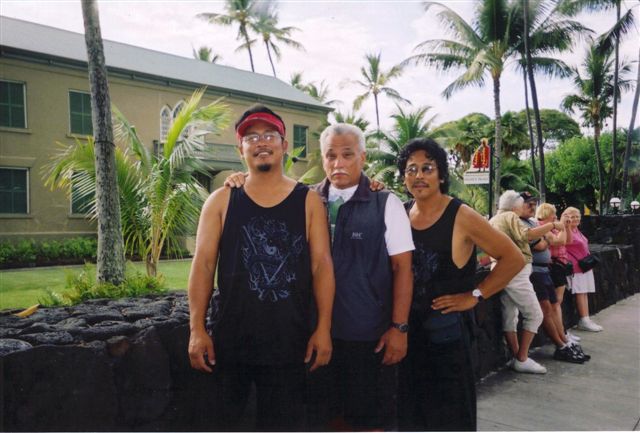The journey to the homeland for a worker, a father an Escrimador!
 |
|
by Tony Robles Jimmy, Jimmy, oh Jimmy Mack --Martha Reeves and the Vandellas It was 1980 and the thick smell of sugar cane from the factory was heavy in the air. My family had just moved to Waipahu, Hawaii from San Francisco. I would walk the roads with the red clay earth under my feet. I was a newcomer. I didn't know the history of where I was. All I really knew were the messages I got from tourist propaganda. I didn't know about the Hawaiian monarchy and how it was overthrown by the US. I didn't know about the workers who had labored under severe conditions on the sugar and pineapple plantations in the early days. I had no idea that Pilipino workers had shut down the factories to protest inhuman working conditions. All I knew was the dirt under my feet. I tried hard to get rid of it. My father, Jimmy Robles, had taken a chance moving to Hawaii. He labored more than 20 years as a janitor for the city and county of San Francisco. One day he said goodbye. He, his wife, my brother and sister and I packed up and moved to Hawaii. My grandmother had warned my father against the move. To her, the smart thing was to remain in his job, retire and collect a pension. Life in Hawaii was hard. The economy was bad and nobody seemed to have any money. My father had started his own janitorial business in San Francisco and brought his equipment to Waipahu. His vacuum cleaner, mops, brooms and floor waxing machine sat idly near a mango tree in the backyard of his father in law's house. My father walked the same road that I did. He said he was looking for work he wasn't but he was looking for something else, something deeper. Somehow I knew he was looking. And while I was at school listening to a girl say to me, "You talk like one haole" the same red earth clung to the bottom of my father's feet in Waipahu when he came upon a house. Unlike me, he didn't try to get the dirt off his feet. "I was in Waipahu," my father says as he recalls that day over 20 years ago, "I saw these guys in a garage. It was a beautiful dance. A guy in a ponytail came out. His name was Snooky Sanchez. He knew my father and my brother. I watched these guys sparring and I was inspired. I sought out this art. What my father had encountered on that day was the Pilipino fighting art of Escrima. Escrima is a Philippine fighting style which utilizes sticks, knives and open hand techniques as well as fluid body movements and footwork. The movements are explosive. The origins of the art predate the Spanish invasion and subsequent colonization of the Philippines. My father explains the warrior's mentality that goes with being a successful practitioner of the art. "To do well, you have to have a war mentality. You have to be strong and in condition. You have to be in total relaxation and from that come a burst of energy. You go down into your spirit; you go beyond your limit." My father worked at the art and became an instructor, an indigenous warrior scholar who has resisted the American occupation and colonization of his mind, heart and spirit. He befriended another martial artist, Joe Behic, AKA Joe the volcano, and the two experimented with the art, synthesizing different styles, developing their own style that they've named Sayaw Ng Mandirigma, which means "Dancing with the warriors" in Tagalog. "Our style is like a cobra. As we retreat, we're ready to attack at any time. It's a reality-based combat. We developed this system over a period of 5 years." My father says that in the old days, you learned the art through your family only. Hawaii is an integral center for martial arts people have come from all over for generations, bringing their different styles. "A lot of masters came and planted roots here in Hawaii," dad says. I remember my father trying to pass the art to me. He'd take his sticks and he'd show me the basic strikes, which I still remember. For some reason I didn't take to it. Perhaps it was the bad memories I had of him showing me boxing, with me on the receiving end of more punches than I landed. I ended up gravitating towards writing. My father was in Hawaii with some of his Escrima students when he was invited to attend an Escrima world championship tournament on the Island of Cebu in the Philippines. My father's parents arrived in the US in the early 1920s. This will be his first visit to the birthplace of his parents. "I'm happy to go to the motherland, the roots. My people came from there. It's gonna be emotional for me. The students he will accompany will be visiting for the first time as well. It is befitting that this world championship will be held on the Island of Cebu, the place that Ferdinand Magellan was killed by the Philippine warrior Lapu Lapu in an act of resistance to the colonizing of the Spaniards. He leaves for Cebu on July 16th. When he gets off the plane I'm sure he will have the same red earth on the bottoms of his feet, having arrived just in time to dance that beautiful dance which is his life. |



